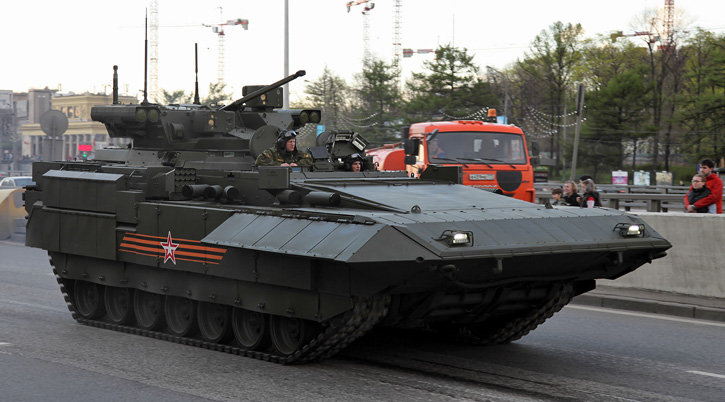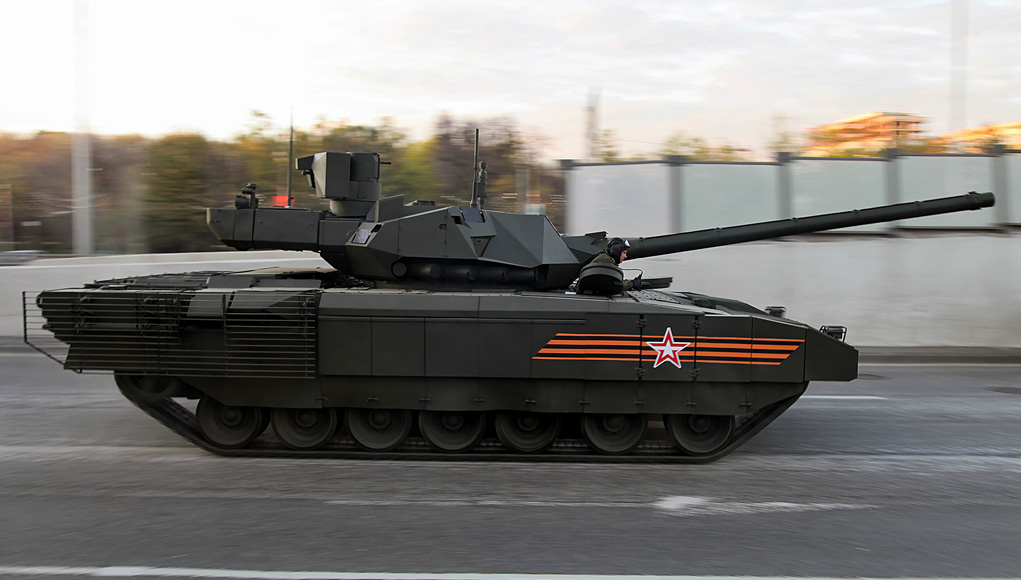[nonmember]
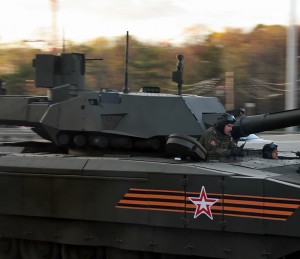
[/nonmember]
The Russian Ministry of defense is lifting the veil on a new family of combat vehicles that has been under development in the past years. The new family scheduled to enter service with the Russian ground forces in the next years will be unveiled in public for the first time May 9th, 2015 on the traditional ‘Victory Day Parade’, marking the 70th anniversary of the victory over Nazi Germany.[ismember]

[/ismember]The new family of vehicles consists of the Armata, a new tracked platform that will replace existing platforms that have been used in the T72 and T90 tanks since the mid-70s. The platform provides a common chassis for some 13 different combat vehicles weighing below 50 tons. [nonmember]
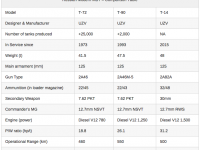
[/nonmember]These include the new T-14 main battle tank that weighs 48 tons and T-15 infantry carrier; a new variant of the tank support vehicle (Terminator), an armored recovery vehicle (ARV), MT-A bridgelayer, Combat Engineering Vehicle (CEV), BMO-2 support vehicle carrying multiple launchers of thermobaric rockets, and USM-1 minelayer. Another variant that could be added in the future is a self propelled artillery system (SPG). However, the new Coalitziya SM SPG displayed on the May 9 parade is still based on the T-90 chassis.
[ismember]
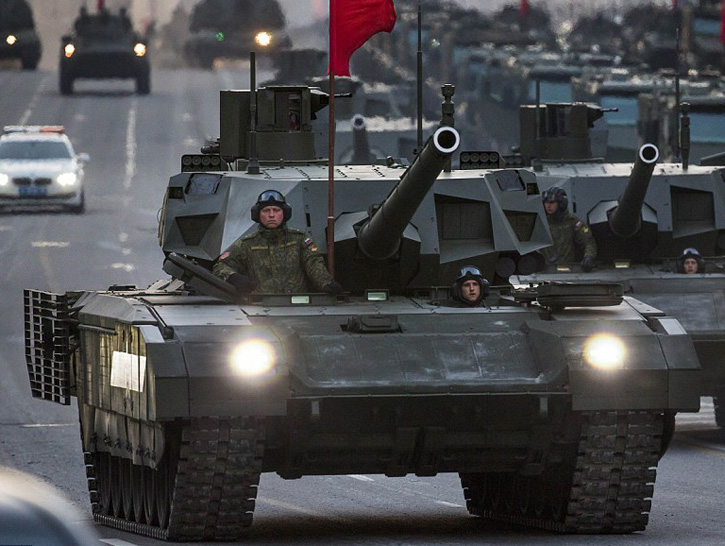
All vehicles are designed and built by UralVagonZavod. Both vehicles are equipped with unmanned turrets, operated from inside the vehicle.
The T-14 has a crew of three, and its unmanned turret comprises the 2A82A 125mm turret with bustle-mounted autoloader with 32 rounds. This weapon is believed to over improved accuracy over 2A46M that operated on the T-72/90. Both guns are designed to fire firing 3BM-44M APFSDS (armour-piercing fin-stabilised discarding sabot), 3BK21B or 3BK29 high-explosive anti-tank (HEAT-FS), and 3OF26 high explosive fragmentation (HE-FRAG) ammunition which employs time-activated fusing enabling airburst effect, as well as 9M119M Refleks anti-tank guided missiles. The T-14 carries 32 rounds in the autoloading magazine, with additional 16 carried on board (unlike the T-72/T90, reloading of the magazine cannot be done in combat as it requires a crew member access to the enclosed weapon’s compartment.)[/ismember]
[ismember][su_table]
| Russian Modern MBT – Comparison Table | |||
|---|---|---|---|
| Model | T-72 | T-90 | T-14 |
| Designer & Manufacturer | UZV | UZV | UZV |
| Number of tanks produced | +25,000 | +2,000 | NA |
| In Service since | 1973 | 1993 | 2015 |
| Weight (t) | 41.5 | 47.5 | 48 |
| Main armament (mm) | 125 | 125 | 125 |
| Gun Type | 2A46 | 2A46M-5 | 2A82A |
| Ammunition (in loader magazine) | 22/45 | 22/43 | 32/48 |
| Secondary Weapon | 7.62 PKT | 7.62 PKT | 30mm |
| Commander’s MG | 12.7mm NSVT | 12.7mm NSVT | 12.7mm RWS |
| Engine (power) | Diesel V12 780 | Diesel V12 1,250 | Diesel V12 1,500 |
| P/W ratio (hp/t) | 18.8 | 26.1 | 31.2 |
| Operational Range (km) | 460 | 550 | 500 |
| Maximum speed (km/h) | 60 | 65 | 80 |
[/su_table]
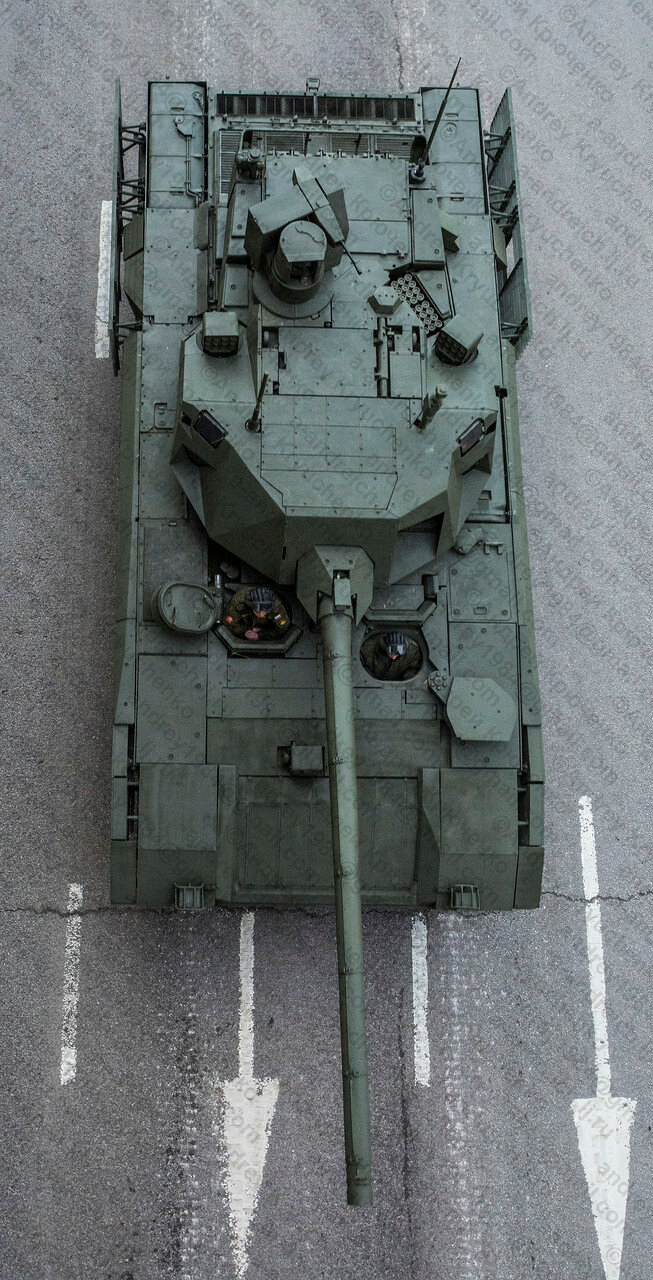
The secondary, automatic 30mm gun is mounted coaxial but, according to some analysts, has a super-elevation feature that enables it to better engage aerial targets such as helicopters and unmanned vehicles. The T-14 carries a separate remotely operated weapon station mounting 12.7 machine gun. This weapon station is installed on top of the turret, thus dominating the tank’s surrounding for self-protection from close-range anti-tank weapons, suicide bombers, assaulting personnel approaching attempting to lay belly charges etc.
Situational awareness in close range is maintained by peripheral vision system integrating cameras on all sides, front and rear. The MMW Active Electronic Scanning Array (AESA) radar providing the main sensor for the Afganit active protection system can also be integrated into the battle management system, providing an updated situational picture tracking moving targets and other objects at close and medium range.
As a common chassis Armata comprises a drive train powered by 12 cylinder 1,500 HP turbo-charged, air cooled diesel engine coupled to an 8-speed automatic transmission that accelerates the tank to a maximum speed of 70-75 km/h. The engine and transmission are coupled into a drive train that can be replaced in the field in 30 minutes. The tank is equipped with auxiliary power unit (APU) sustaining ‘silent watch’ with main engine shut down. The suspension system has seven dual rubber-tyred road wheels, and four track support rollers.
A gunner’s sight and independent panoramic sight for the commander enable the tank crew to detect and engage targets at ranges of more than 5,000 meters. The capsule protecting the crew area, weapon system, ammunition comprises more than 900mm of ballistic armor, part of which consists of the new 44S-sv-Sh developed by the ‘Ural Steel Research Institute’. In addition, the T-14 has an integrated active protection system (Afganit).[/ismember]
An inspection of the T-14 tanks rehearsing for the May 9 parade shows a combination of layers of modular armor comprising active and hybrid protection. Adding protection beyond the frontal arc and sides is a common design feature today, adapting MBTs for combat in complex, urban terrain, where threats exist over 360 degrees.
[nonmember]Subscribe to read the full version of this article
Only $7.95 / month[/nonmember]
Additional slat armor is used to protect the engine compartment and enable easy access to the sprocket. The forward section of the belly mounts an active counter-mine protection. Countermeasure dischargers firing instant smoke obscurants are employed, on both sides of the turret as part of the overall protection system.
[ismember]The clear distinction between the crew compartment, weapon’s section and ammunition enabled the tank designers to tailor the T-14 armor suite to increase the protection of specific areas, while maintaining the overall envelope of the vehicle within the dimensional limits of rail and air transportation. Russian Army has practiced the delivery of T-72/T-90 tanks in An-76 transport aircraft and in the future, the Russian military is seeking the capability to air transport a complete army, anywhere in the world, using mega-transport planes.[/ismember]
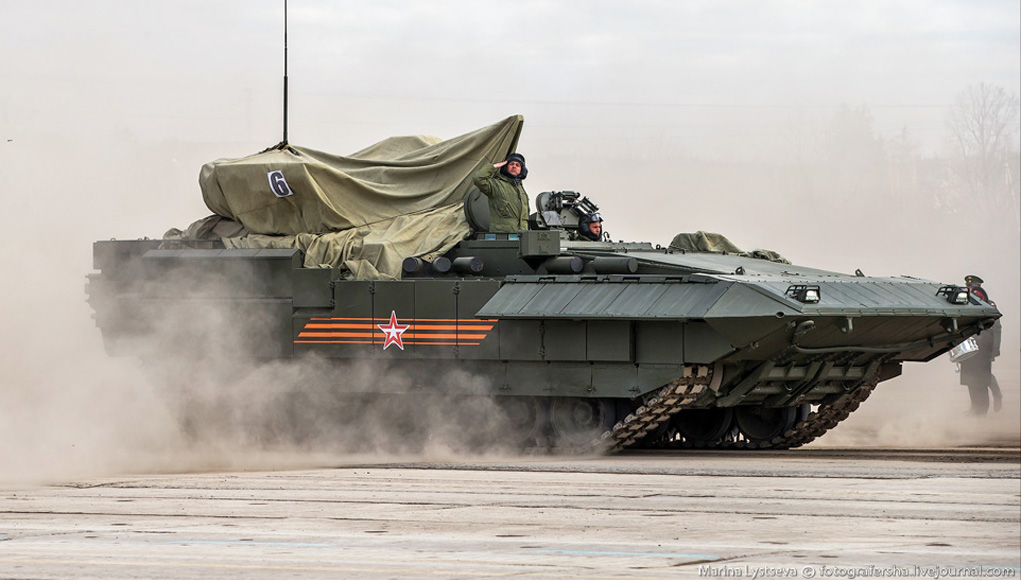
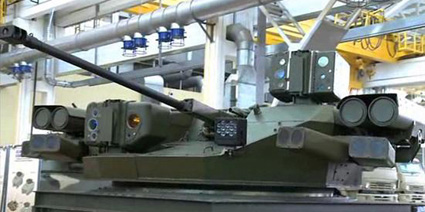
The T-15 IVF (BMP) also shares the common Armata chassis. As a troop carrier, it will replace the current BMP-2 variants offering much improved mobility and protection although at a significant weight increase. The vehicle is operated by three crew members and accommodates eight troops. It is likely to be equipped with a new remotely operated weapon station designed by KBP. This turret mounts the 2A42 30mm cannon with 500 rounds, 7.62 coaxial machine gun and four Kornet-EM guided missiles (two on each side). The T-15 shares a protection system similar to that of Armata.[ismember]
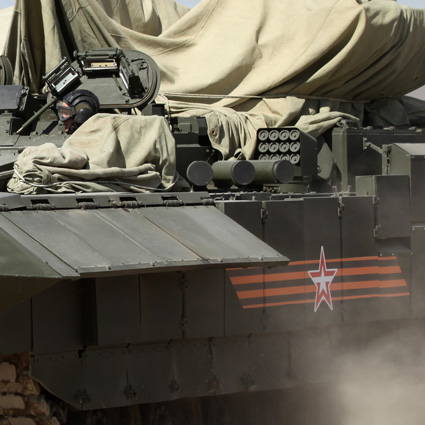
To allow rapid and efficient access to the troop compartment the engine is positioned at the front, providing the vehicle a distinctive, pointed profile.
Overall, the T-15 posed more challenging requirements for the armor designers, as it required providing heavier all-round protection, rather than the ¾ protection used on the T-14.
Positioning the engine in front required increased protection, using modular oblique add-on armor at the frontal arc adding significantly to the width to the vehicle. It is likely that those modules will be detachable to overland, marine or air transportation.
(Thinner and lighter slat armor was sufficient to protect the rear area surrounding the engine compartment of the T-14 Armata). T-15 also uses an active counter-mine system, similar to that used on the T-14.
Other distinctive features are the countermeasure dischargers scattered along the two sides of the vehicle.
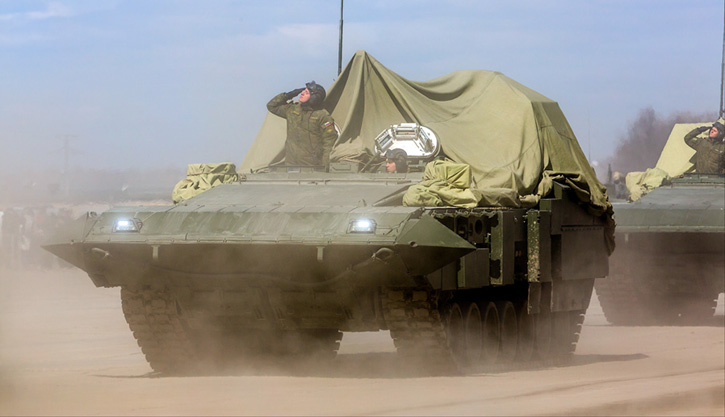
[/ismember]
